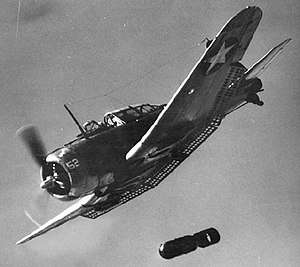Dive brake
Dive brakes or dive flaps are deployed to slow down an aircraft when in a dive. They often consist of a metal flap that is lowered against the air flow, thus creating drag and reducing dive speed.[1]

The dive brakes on this SBD Dauntless are the slotted panels visible under the wings.

Schempp-Hirth type airbrakes/spoilers on a Slingsby Capstan
In the past, dive brakes were mostly used on dive bombers, which needed to dive very steeply, but without exceeding their red line speed, in order to drop their bombs accurately. The airbrakes or spoilers fitted to gliders often function both as landing aids, to adjust the approach angle, and to keep the aircraft's speed below its maximum permissible indicated air speed in a vertical dive. Most modern combat aircraft are equipped with air brakes, which perform the same function as dive brakes.[1][2]
Applications
- Aichi D3A
- Dornier Do 217 (attachable dorsal/ventral "petal" design at extreme rear of fuselage)
- Douglas SBD Dauntless
- Junkers Ju 87
- Nelson Hummingbird PG-185B
- Northrop BT
- Schweizer SGS 2-33
gollark: So all I need to do is badly crop my memes and they're IMPERVIOUS to report detection?
gollark: Hmm. This is 800 lines of C++. This might be a problem.
gollark: I'm looking into how exactly it works so I can try randomly fuzzing images a bit to beat it.
gollark: I should make a thing to try and beat perceptual hashes.
gollark: It probably hasn't indexed old ones.
References
- Crane, Dale: Dictionary of Aeronautical Terms, third edition, page 168. Aviation Supplies & Academics, 1997. ISBN 1-56027-287-2
- Shenstone, B.S.; Wilkinson, K.G. (1963). The World's Sailplanes. II. Organisation Scientifique et Technique Internationale du Vol à Voile (OSTIV) and Schweizer Aero-Revue. p. 117.
This article is issued from Wikipedia. The text is licensed under Creative Commons - Attribution - Sharealike. Additional terms may apply for the media files.